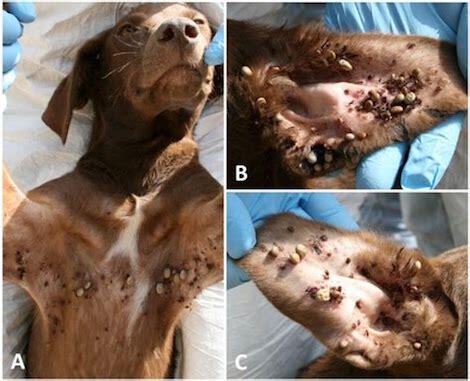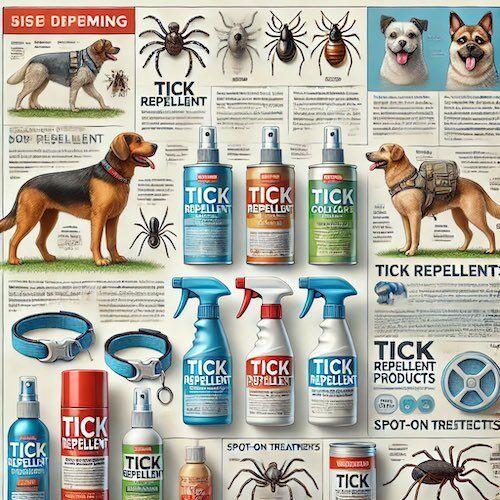
Lyme Disease in Dogs: Essential Facts and Prevention Tips
1. Introduction to Lyme Disease in Dogs
Lyme disease is a widespread and potentially debilitating condition that affects both humans and animals. In dogs, it can lead to severe health issues if not detected and treated promptly. Understanding Lyme disease, its symptoms, and preventive measures is crucial for pet owners who want to keep their dogs healthy and happy.
Dogs are more susceptible to tick bites and Lyme disease because they are often exposed to environments where ticks are prevalent, such as wooded areas, parks, and yards. Pet owners must be vigilant in checking their dogs for ticks and implementing preventive measures to reduce the risk of Lyme disease.
The increasing prevalence of Lyme disease in certain regions has made it essential for dog owners to be aware of the signs and symptoms of the disease. By recognizing early symptoms and seeking prompt veterinary care, the severity of the disease can be minimized, and long-term complications can be avoided.
2. Understanding Lyme Disease
What is Lyme Disease?
Lyme disease is an infectious disease caused by the bacterium Borrelia burgdorferi. It primarily affects dogs, humans, and other animals. The disease is named after Lyme, Connecticut, where it was first identified in the 1970s. Lyme disease is a vector-borne disease, meaning it is transmitted through a vector, in this case, ticks.
The bacterium Borrelia burgdorferi belongs to the spirochete family, characterized by its spiral shape. Once inside the host, the bacteria can travel through the bloodstream and settle in various tissues, leading to a range of symptoms. Lyme disease is most commonly reported in North America and Europe, but it can occur in other regions where ticks are present.
Search: Best Selling Natural Antibiotics for Dogs
Understanding the lifecycle and behavior of ticks is essential for preventing Lyme disease. Ticks are small arachnids that feed on the blood of mammals, birds, and reptiles. They are found in grassy, wooded, and brushy areas, where they wait for a host to pass by. Once they attach to a host, they feed for several days, during which time they can transmit the bacteria that cause Lyme disease.
How is Lyme Disease Transmitted?
The primary vector for Lyme disease is the black-legged tick, also known as the deer tick (Ixodes scapularis). Ticks become infected with Borrelia burgdorferi when they feed on infected wildlife, such as deer, rodents, and birds. Once infected, ticks can transmit the bacteria to dogs and other hosts through their bites.
Ticks go through four life stages: egg, larva, nymph, and adult. Both nymphs and adult ticks can transmit Lyme disease. Dogs are most at risk during the spring and summer months when ticks are most active. The risk of transmission increases if the tick remains attached for more than 24 hours, highlighting the importance of regular tick checks and prompt removal.
Ticks have specialized mouthparts that allow them to anchor themselves firmly to the host’s skin. While feeding, ticks secrete saliva that contains compounds to prevent blood clotting, reduce pain and inflammation, and suppress the host’s immune response. These compounds facilitate the transmission of Borrelia burgdorferi from the tick to the host.
Preventing tick bites is the most effective way to protect your dog from Lyme disease. Understanding tick habitats and behaviors can help you take proactive measures to minimize the risk of tick exposure.
3. Symptoms of Lyme Disease in Dogs
Early Signs
The symptoms of Lyme disease in dogs can vary widely and may not appear until several weeks or months after a tick bite. Early signs of Lyme disease in dogs include:
- Lameness: Intermittent lameness that shifts from one leg to another is a common early sign. This lameness is often due to inflammation in the joints. Dogs may suddenly become lame, and the lameness may appear to resolve on its own, only to recur in a different limb.
- Fever: Dogs with Lyme disease may develop a fever, typically ranging from 103°F to 105°F. A fever can indicate an immune response to the infection and is often accompanied by other signs of illness.
- Loss of Appetite: Affected dogs may show a decreased interest in food. This can be due to a general feeling of malaise or discomfort caused by the infection.
- Lethargy: Dogs may become unusually tired or lack energy. Lethargy is a common symptom of many infections, including Lyme disease, and can affect a dog’s overall behavior and activity levels.
- Swollen Lymph Nodes: Enlarged lymph nodes, particularly near the site of the tick bite, can occur. Lymph nodes act as filters for foreign particles and are part of the body’s immune response to infection.
Advanced Symptoms
If left untreated, Lyme disease can lead to more severe health problems, including:
- Kidney Damage: In severe cases, Lyme disease can cause glomerulonephritis, a condition that damages the kidneys and can lead to kidney failure. Symptoms of kidney damage include increased thirst and urination, vomiting, weight loss, and edema (swelling due to fluid retention).
- Heart Problems: Lyme disease can cause inflammation of the heart, leading to abnormal heart rhythms and other cardiovascular issues. This condition, known as Lyme carditis, can cause symptoms such as fainting, exercise intolerance, and heart murmurs.
- Neurological Issues: Dogs may develop neurological symptoms such as facial paralysis, seizures, and behavioral changes. Lyme neuroborreliosis, although less common, can affect the nervous system and lead to serious complications.
- Chronic Joint Pain: Persistent joint inflammation and pain can occur, leading to long-term mobility issues. Dogs may experience difficulty walking, stiffness, and a reluctance to move or exercise.
Recognizing the signs and symptoms of Lyme disease early can significantly improve the chances of successful treatment and recovery. Pet owners should be vigilant and seek veterinary care if they notice any unusual changes in their dog’s behavior or health.
4. Diagnosis of Lyme Disease in Dogs
Veterinary Examination
If you suspect your dog has Lyme disease, it is essential to seek veterinary care promptly. The veterinarian will perform a thorough examination and review your dog’s medical history, including any recent tick exposure. A detailed physical examination can help identify signs of Lyme disease, such as lameness, fever, and swollen lymph nodes.
During the examination, the veterinarian may ask about your dog’s outdoor activities, travel history, and any known tick exposure. This information can help assess the likelihood of Lyme disease and guide further diagnostic testing.
Diagnostic Tests
Several tests can help diagnose Lyme disease in dogs:
- Blood Tests: Blood tests such as the SNAP 4Dx or C6 antibody test can detect antibodies produced in response to Borrelia burgdorferi infection. These tests are quick and can provide results within minutes. They can also screen for other tick-borne diseases, such as anaplasmosis and ehrlichiosis.
- PCR Test: Polymerase chain reaction (PCR) testing can detect the presence of bacterial DNA in a dog’s blood. This test is highly specific and can confirm an active infection. PCR tests are useful for identifying the genetic material of Borrelia burgdorferi and can provide definitive evidence of infection.
- Urinalysis: A urinalysis can help check for kidney damage or dysfunction, which is a common complication of Lyme disease. The presence of protein in the urine (proteinuria) can indicate kidney involvement and the need for further evaluation and treatment.
- Joint Fluid Analysis: In cases of lameness or joint swelling, analyzing joint fluid can help identify the cause of inflammation and confirm a Lyme disease diagnosis. This test involves collecting a sample of joint fluid and examining it for signs of infection or inflammation.
Early diagnosis and treatment of Lyme disease are crucial to prevent long-term complications. If you suspect your dog has been exposed to ticks or is showing symptoms of Lyme disease, schedule an appointment with your veterinarian as soon as possible.
5. Treatment of Lyme Disease in Dogs
Antibiotic Therapy
The primary treatment for Lyme disease in dogs is antibiotic therapy. The most commonly prescribed antibiotics include doxycycline, amoxicillin, and azithromycin. Treatment typically lasts for 4-6 weeks, although longer courses may be necessary in some cases. Prompt treatment with antibiotics can help reduce the severity of symptoms and prevent complications.
Doxycycline is often the antibiotic of choice due to its effectiveness against Borrelia burgdorferi and its ability to penetrate tissues and reach areas where the bacteria may be hiding. Amoxicillin and azithromycin are also effective alternatives, and the choice of antibiotic may depend on the dog’s specific needs and any potential side effects.
Supportive Care
In addition to antibiotics, supportive care may be required to manage symptoms and promote recovery. This can include:
- Pain Relief Medications: For joint pain and swelling. Nonsteroidal anti-inflammatory drugs (NSAIDs) such as carprofen and meloxicam can help reduce pain and inflammation.
- Anti-inflammatory Drugs: To reduce inflammation. Corticosteroids may be prescribed in some cases to manage severe inflammation, although their use is typically limited due to potential side effects.
- Fluid Therapy: For dogs with kidney issues to maintain hydration and support kidney function. Intravenous (IV) fluids can help flush toxins from the kidneys and prevent dehydration.
- Dietary Adjustments: Special diets may be recommended to support overall health and recovery. Dogs with kidney involvement may benefit from a low-protein, low-phosphorus diet to reduce the workload on the kidneys.
Monitoring and Follow-Up
After completing the antibiotic course, follow-up visits to the veterinarian are crucial to ensure the infection is fully cleared and to monitor for any signs of recurrence. Regular check-ups can help detect any lingering symptoms or complications early, allowing for timely intervention.
During follow-up visits, the veterinarian may perform additional blood tests or other diagnostic procedures to assess the dog’s response to treatment and ensure that the infection has been effectively eradicated. Long-term monitoring may be necessary for dogs with severe or recurring symptoms.
6. Prevention of Lyme Disease in Dogs
Tick Control
Effective tick control is the cornerstone of Lyme disease prevention. Here are some tips to reduce the risk of tick bites:
- Tick Preventatives: Use veterinarian-recommended tick preventatives, such as topical treatments, collars, or oral medications, to protect your dog from ticks. These products can kill ticks on contact or after they bite your dog, reducing the risk of disease transmission. Examples of tick preventatives include fipronil, permethrin, and fluralaner.
- Tick Checks: Perform regular tick checks on your dog, especially after spending time outdoors. Pay close attention to areas where ticks commonly attach, such as the ears, neck, and underbelly. Remove any ticks promptly using fine-tipped tweezers. Grasp the tick as close to the skin’s surface as possible and pull upward with steady, even pressure to avoid leaving mouthparts embedded in the skin.
- Grooming: Keep your dog’s fur trimmed, particularly in areas prone to tick attachment. Regular grooming can help you spot ticks early and remove them before they can transmit diseases. Bathing your dog with tick-repellent shampoos can also help reduce the risk of tick attachment.
- Avoid Tick-Infested Areas: Avoid walking your dog in areas known to be heavily infested with ticks, such as tall grasses, dense woods, and leaf litter. Stick to well-maintained paths and trails to reduce the risk of tick exposure. If you must enter tick-prone areas, consider using tick repellent products on your dog’s fur and skin.
Vaccination
Vaccination against Lyme disease is available and can be an additional preventive measure, particularly for dogs living in or frequently visiting high-risk areas. Consult your veterinarian to determine if the Lyme disease vaccine is appropriate for your dog. Vaccination can help reduce the severity of symptoms if your dog does become infected.
The Lyme disease vaccine works by stimulating the dog’s immune system to produce antibodies against Borrelia burgdorferi. These antibodies can neutralize the bacteria before they establish an infection. The vaccine is typically administered as an initial series of two injections, followed by annual boosters.
While the vaccine can provide an added layer of protection, it should be used in conjunction with other preventive measures, such as tick control and regular tick checks. No vaccine is 100% effective, and maintaining a comprehensive approach to Lyme disease prevention is essential.
Environmental Management
Managing your environment can also help reduce the risk of tick exposure:
- Yard Maintenance: Keep your yard well-maintained by regularly mowing the lawn, removing leaf litter, and trimming bushes and trees to reduce tick habitats. Creating a tick-free zone around your home can significantly lower the risk of tick bites. Consider using tick control products in your yard, such as acaricides, to reduce the tick population.
- Fencing: Install fencing to keep wildlife, which can carry ticks, out of your yard. Deer and other animals can bring ticks into your yard, so reducing their access can help control the tick population. Clear brush and debris along the perimeter of your yard to create a buffer zone that deters wildlife from entering.
- Tick-Repellent Landscaping: Consider landscaping techniques that deter ticks, such as using gravel or wood chips to create a barrier between wooded areas and your lawn. Tick-repellent plants, like lavender and marigold, can also help keep ticks away. Planting these and other tick-repellent species around your yard can create a natural barrier to tick entry.

7. The Importance of Early Detection and Prevention
Educating Pet Owners
Awareness and education are crucial for preventing Lyme disease in dogs. Pet owners should be informed about the risks, symptoms, and prevention strategies to protect their furry companions effectively. Regular communication with your veterinarian and staying informed about tick activity in your area can help you stay ahead of potential risks.
15 Dog Breeds With The Highest Cancer Rates
Pet owners should also be aware of the signs and symptoms of Lyme disease and the importance of regular veterinary check-ups. Early detection and treatment can significantly improve the prognosis for dogs with Lyme disease and reduce the risk of severe complications.
Educational campaigns and resources, such as informational brochures, online articles, and community workshops, can help raise awareness about Lyme disease and its prevention. Veterinarians and veterinary clinics play a key role in educating pet owners and providing guidance on effective preventive measures.
Community Involvement
Community involvement, including public health campaigns and cooperation with local veterinary clinics, can help spread awareness and provide resources for tick control and Lyme disease prevention. Participating in community events, distributing educational materials, and supporting local initiatives can contribute to a broader effort to reduce the incidence of Lyme disease in dogs.
Community programs that promote tick control and Lyme disease prevention can have a significant impact on public health. Collaborating with local government agencies, schools, and community organizations can help reach a wider audience and encourage collective action to reduce tick populations and prevent Lyme disease.
Public health campaigns can also emphasize the importance of environmental management and the role of individuals in maintaining tick-free areas. Community clean-up events, educational seminars, and tick awareness days can engage the public and foster a sense of responsibility for preventing Lyme disease.
8. Conclusion
Lyme disease in dogs is a serious but preventable condition. By understanding the disease, recognizing its symptoms, and implementing effective prevention strategies, you can protect your dog from this potentially debilitating illness. Regular veterinary care, vigilant tick control, and prompt treatment are key to ensuring your dog’s health and well-being. Remember, prevention is always better than cure, and taking proactive steps to safeguard your dog from Lyme disease is one of the best things you can do for their long-term health.
